Tips and Tricks for Boondocking
So You Have Solar Electricity, Now What? Recently we pulled into a campground with water being the only amenity. We parked alongside another RV who had been boondocking for half a day and already had a full gray water tank. It reminded us that not everyone is an experienced full-timer, having figured out how to extend a boondocking stay by conservation and ingenuity while camping.
The major reason RVers deck their RV with solar panels is for the purpose of boondocking. This only takes care of one aspect of being self-sufficient. In a full hook-up site, you also have unlimited water and a sewer hook-up to get rid of black and gray water. With solar energy, you no longer have the need to find a “current” bush, but what about the lack of water and sewer while boondocking?
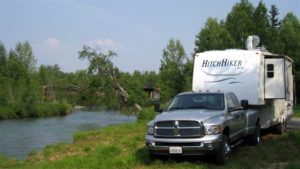
No hook-ups for miles in the wilderness of Alaska.
Experienced full-timers have come up with a variety of ways to extend their boondocking stay in a national forest or other dry camping situations. We will share how we do it. It is not the only way, but works well for us. Most campgrounds have at least one water spigot, but if not we have even pumped water from a nearby stream using an extra RV water pump hooked to a battery and running the water through a filter. If this water is also used for drinking it is run through a second, smaller micron filter.
Catch All Gray Water: The first rule of extended boondocking is to prevent any water going into the gray tank if at all possible. We catch all our water from showers, dishes and the bathroom sink by placing rubber tubs in each of these locations. (The tubs we use are the same ones we pack stuff into when we are moving, so they do double duty).
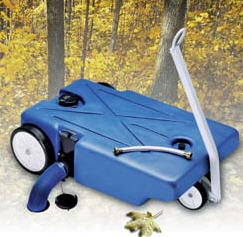
Blue Boy tote-tank
It is illegal to dump an RV gray tank onto the ground, but if you catch that water before it goes into the tank, you are considered in the same category as a tent camper, and can water the bushes as long as you are using biodegradable products while boondocking. We have also stayed at Thousand Trail parks with a dump station, but no campsite sewer hook-up. If the dump is close by, we just ferry our water over to the dump in 2 gallon or 5 gallon buckets as we collect it. You can also use a Blue boy tote to make less trips.
Otherwise, in most campgrounds we just water the bushes, or pour grey water in the fire pit.
Black Tank Management: For some reason, RVs proportionally have a large enough black tank that it can easily go a month without dumping, if you are conservative. We installed a shut-off valve so that we do not use water from the fresh tank to flush the toilet.
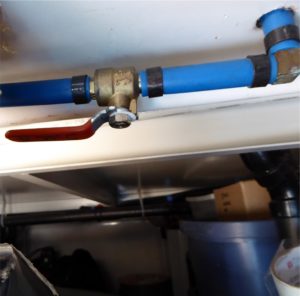
An easy open/close valve installed in water source going to the toilet.
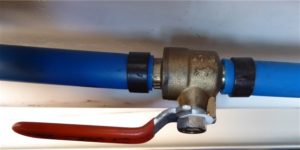
Close-up of shut-off valve
You can also save room in the tank by not putting tissue down the toilet. Tissues can be collected in a plastic grocery bag to be burned or deposited in a dumpster each day. Use captured dishwater, or bathroom sink water to flush the toilet. Use the least amount possible to do the job. You can also use the “if it’s yellow, let it mellow, if it’s brown, flush it down” method. That way, you only add water when you #2. You only need enough water to cover the seal at the bottom of the bowl, about 1 cup. We have never had to leave a campsite due to a full black tank. We may only have to add a bit more enzyme to the tank to keep it smelling good. Of course, if there are pit toilets or any other form of toilets in a campground, we use those during the day, reserving space in the RV black tank for nocturnal contributions only.
Tips for Water Conservation: Depending on how often you feel like going to the trouble of filling the fresh water tank, you can be a little or a lot conservative. For us, taking a shower at least once a day is a must. Normally, we both shower morning and night. If we are being ultra conservative, we will use disposable wipes to wipe down the entire body, then a hot washcloth. Personally, we prefer to put about 2 quarts of hot water in the tub we have in the bathroom sink, use shower gel or soap to lather up and then wipe off with a hot washcloth. This is the night routine. In the morning when we need to wash our hair, it has to be a shower. You can still get by with about 1 – 1 1/2 gallons of water by using the on/off button on the RV shower wand. Quickly get wet, turnoff the water and then soap up head-to-toe and use shampoo. Turn the water on and quickly rinse off. The water is caught in a Rubbermaid tub (shown above) and poured into a bucket to be used for the toilet, or thrown outside.
Plan Meals Ahead to Conserve Water: Of course, the use of paper plates and planning meals not requiring a lot of cooking and clean-up is important as well. If we are going to be boondocking for an extended time, we make several salads, precook pasta and put together meals that just require reheating in the microwave or over the campfire.
Replenishing the Fresh Water Tank: No matter how conservative you are, if you stay much more than a week or two, you will need to replenish your fresh water. If the water source is not too far away, we use 3 gallon jugs with handles or 5 gallon buckets to ferry the water to the RV by hand. Think of it as a workout routine for the day. If the water is too far away, we carry these containers on the tailgate of our pick-up and drive back and forth. Depending on how high the fill-hole is off the ground, one person can hold a funnel while the other person gets on a ladder to pour the water in. WARNING; the person holding the funnel usually gets wet, which is not a bad deal, if it is a hot day. We carry an extra RV water pump, which we hot-wire to the RV batteries, or the battery in our truck. A shorter piece of hose comes off the pump and into the bucket or water jug for sucking out the water. The other end is the regular water hose going up to the RV. Our fresh water tank holds about 52 gallons and with running back and forth and filling, we can usually fill the tank in less than an hour, which will last us another week or two.
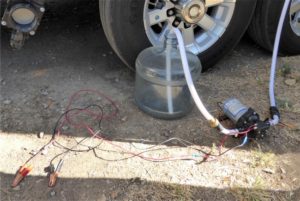
An RV water pump pumps water from a jug or bucket. The pump is wired to hook to and RV battery or your vehicle battery.
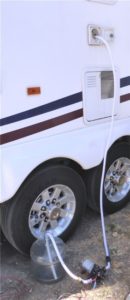
The other side of the pump has a connection for the water hose, to move the water into the RV fresh water holding tank
As I said , these are the things that work well for us, and may give newbies a starting point for coming up with your own ideas. For those of us who love to be away from it all, being self sufficient (but still enjoying all the amenities), it is important to have a plan going in. We find it a fun challenge to see how little water we can use so that we can extend our stay even longer in favorite places. If you would like more information on boondocking locations, there are very handy Bookdocking Guide Books available through frugal-rv-travel.com.
If you are considering solar energy and don’t know where to start, check out the all the information located on our website. Go to www.PrecisionRV.com and click on RV Solar near the top of the homepage.


You must be logged in to post a comment.